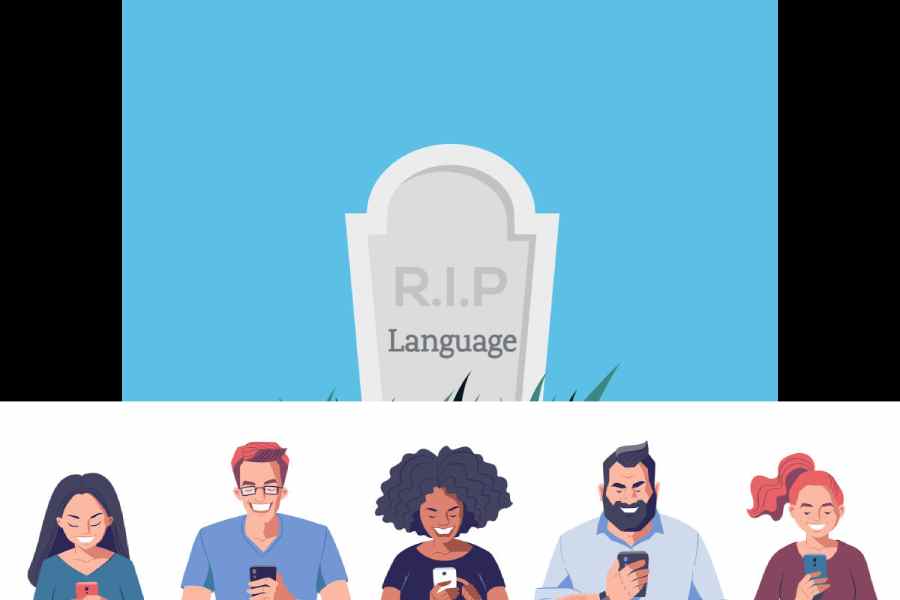The three superlative inventions that humans made include the making and the using of tools, the domestication of fire, and the articulation of thought through the use of signs. These three set apart Homo sapiens from all other species. Although quite arbitrary, language is a ‘system of signs’. Until writing emerged as a mark of civilisation, linguistic signs were essentially signs formed out of sound waves. Scripts and writing were the ‘surpluses’ of language, its mirror image, its representation, but never ‘language itself’. The idea that a mature language is one that has gained its representation in writing, printing and long-distance distribution is not scientifically accurate even though it is culturally irreversible.
Humans have used language for millennia prior to the emergence of writing. With the inception of scripts, natural languages acquired a new ability. Humans became capable of carrying speech far beyond its immediate space and time, particularly when printing technology came in. Of course, the meanings of words shift from location to location and, more decidedly, from one epoch to another epoch. But that slide or shift is a limitation — one may even say it is a gift — that natural languages have to carry with them as a kind of a birthmark. Scripts were conceptualised initially to record complicated economic transactions involving production that was getting to be seen not just as material but also as material with economic value. It included human labour. It also included inheritance or property. Thus, in ancient times, natural languages started demanding to be scripted when the speech communities using them developed production practices, giving rise to the concepts of ‘surplus’, ‘exchange’ and ‘value’.
Yet, whether entirely oral or having representation through writing, the languages used by humans are described as ‘natural languages’. At the beginning of the present century, Unesco’s estimate of the number of natural languages in existence was about 6,000. What is common to all those languages — except the sign languages — is that all of them use voice or sound to signify meaning. There is widespread fear that a large majority of them may not be around by the end of this century. The 1961 Census of India had reported 1,652 mother tongues. In 2011, the number had gone down to 1,369, marking a loss of 283 mother tongues in the intervening period of 50 years. It is a daunting task to determine as to which languages have come closest to the state of aphasia, which ones are decidedly moving in that direction, and which ones are merely going through the natural linguistic process of transmigration. Language is not only a social system of verbal icons, arbitrarily assembled through ages, but it is also a ‘means’ of carrying forward the cumulative human experience of millennia to future generations. When the trajectories of languages get snapped, the accumulated wisdom in those languages, too, gets submerged and continues to survive in severely truncated, irreparable and insensible forms.
Various modes of representation of language have impacted language as speech, so much so that many alluring possibilities of languages that are almost entirely dissociated from speech have started beckoning the human mind. The digital/visual world with its limitless virtual space provides one such possibility. The digital/visual exchange of meaning, liberated from sound, can be compared to a shadow play where shadows signify substance in the absence of what the shadows stand for within the visual field of the viewer. The idea that a shadow has a remarkable referential capacity and versatile signification is not recent. It occurs in ancient Greek philosophy, as it does in the Upanishads. In our time, as the 6,000 or so living languages are caught in a survival crisis, there has been an amazing growth in the universe of the ‘shadow-meaning’ in the exchange of human thought and memory through a phenomenally speedy dissemination of the digital and the visual. It is a move towards not only a new manner of communication but also an altogether different mode of existence.
Two remarkable books can help one grasp the enormity of the shift. One of these is Proust and the Squid, a study of dyslectic children by Maryanne Wolf, a professor at the Centre for Reading of Tufts University. The subtitle of Wolf’s book is “The Story and Science of the Reading Brain”. After examining the neurological history of reading, she comes to the conclusion that probably the ‘non-reading’ dyslectic-types are a necessary part of human evolution. Their relative increase in schools indicates that after artificial memory started occupying a greater space in language transactions, the human brain started relating to language more through visuals than through sound-based signs. The other book is by Michael Charles Corballis and is called The Recursive Mind: The Origins of Human Language, Thought, and Civilization. It presents a comprehensive historical overview of the human neurological-language ability and concludes that the recursive character of the human brain has brought it close to a point of fatigue for sound-based language.
These studies direct one’s attention towards the imminent possibility of the human transition from the established manner of language transaction to a new arrangement of relations between signs and the analytical ability of the human brain. In this new relationship, the simultaneity of senses will become increasingly necessary and expected by the neurological refiguration of cognition, moving communication largely from the language-processing lobe of the brain to the image-processing pre-frontal parts of the brain. Faster communication response and sharper abstraction will dominate the process. In simpler words, the human brain is likely to behave more like an intelligent camera rather than an intelligent teleprinter.
Given the inevitable, one may simply sigh and say ‘salaam evolution!’ but the problem is made worse by the wide economic disparity. Over the last few centuries, particularly since the rise of technologies of language transportation — printing, photocopying, electronic language storage and reproduction, digital encoding and decoding -- language-transmission and language-use have started to get rapidly monetised. Today, as never before, the economically dispossessed classes all over the world are finding it difficult to access language acquisition as per their needs and desires. Thus, throughout the world, we now notice a digital-powered linguistic class and another print- and digital-deprived linguistic class. The divide is too deep to be bridged; a technological reversal is too unrealistic a proposition. As in the case with the climate crisis, the have-nots — the digitally-deprived class — would have to face the brunt of this techno-social aphasia in its worst ferocity.
G.N. Devy is Professor of Eminence & Director, School of Civilisation, Somaiya Vidyavihar University, Bombay










